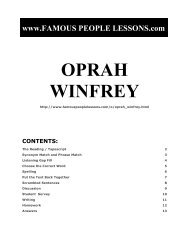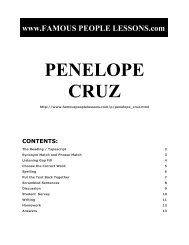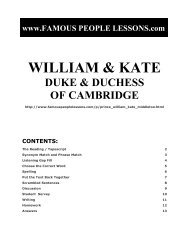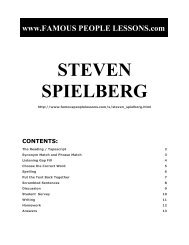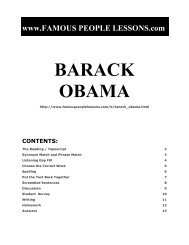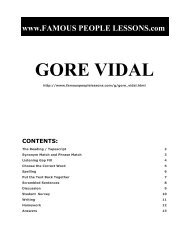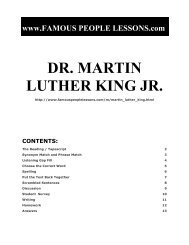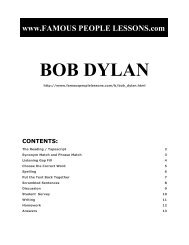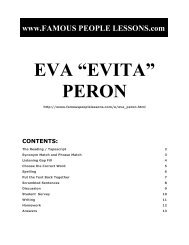TADAO ANDO.pdf - Famous People Lessons.com
TADAO ANDO.pdf - Famous People Lessons.com
TADAO ANDO.pdf - Famous People Lessons.com
Create successful ePaper yourself
Turn your PDF publications into a flip-book with our unique Google optimized e-Paper software.
www.FAMOUS PEOPLE LESSONS.<strong>com</strong><br />
<strong>TADAO</strong> <strong>ANDO</strong><br />
CONTENTS:<br />
http://www.famouspeoplelessons.<strong>com</strong>/t/tadao_ando.html<br />
The Reading / Tapescript 2<br />
Synonym Match and Phrase Match 3<br />
Listening Gap Fill 4<br />
Choose the Correct Word 5<br />
Spelling 6<br />
Put the Text Back Together 7<br />
Scrambled Sentences 8<br />
Discussion 9<br />
Student Survey 10<br />
Writing 11<br />
Homework 12<br />
Answers 13
THE READING / TAPESCRIPT<br />
Copyright © www.<strong>Famous</strong><strong>People</strong><strong>Lessons</strong>.<strong>com</strong> 2<br />
<strong>TADAO</strong> <strong>ANDO</strong><br />
Tadao Ando was born in 1941 in Osaka, Japan. He is a prolific architect<br />
and is in demand the world over. He designs buildings using his<br />
distinctive approach to architecture. His style uses simple forms, lots<br />
of exposed concrete, and the creative use of natural light. <strong>People</strong><br />
describe his work as ‘international modernism’. A leading architectural<br />
critic said: "Ando is right in the Japanese tradition.”<br />
Ando spent his childhood making wood models. He spent hours in a<br />
carpenter’s shop across the street and learnt many techniques from<br />
the craftsmen. After leaving school he drifted from job to job. He was<br />
a truck driver and tried his luck as a boxer. He eventually got into<br />
architecture, even though he had no qualifications.<br />
Ando began teaching himself the principles of designing buildings. He<br />
visited temples and shrines in Kyoto and Nara to get a feel for<br />
traditional Japanese architecture. He also travelled to Europe to sketch<br />
the magnificent buildings there. His maiden project was Tomishima<br />
House in Osaka in 1973. Twenty years later he <strong>com</strong>pleted his first<br />
international project – the Japanese Pavilion at Expo92 in Sevilla,<br />
Spain.<br />
Ando was first recognized for his work in 1979, when he won the<br />
Annual Prize from the Architectural Institute of Japan. In 1995, he<br />
scooped the Pritzker Prize – the highest distinction in world<br />
architecture. He donated the $100,000 prize money to the orphans of<br />
the Kobe earthquake. A housing <strong>com</strong>plex he designed in Kobe survived<br />
the earthquake undamaged.<br />
243 words<br />
Flesch Kinkaid 9.3
Copyright © www.<strong>Famous</strong><strong>People</strong><strong>Lessons</strong>.<strong>com</strong> 3<br />
<strong>TADAO</strong> <strong>ANDO</strong><br />
SYNONYM MATCH: Match the words from the article on the left with their<br />
synonyms on the right. Are your answers the same as other students’?<br />
Paragraphs 1 and 2<br />
1. prolific a. wandered<br />
2 distinctive b. top<br />
3. leading c. unique<br />
4. drifted d. productive<br />
5. eventually e. licenses<br />
6. qualifications f. finally<br />
Paragraphs 3 and 4<br />
7. principles g. sense<br />
8. feel h. won<br />
9. maiden i. gave<br />
10. recognized j. concepts<br />
11 scooped k acknowledged<br />
12 donated l first<br />
PHRASE MATCH: Match the following phrases from the article.<br />
1. in demand a. in world architecture<br />
2 his distinctive approach b. making wood models<br />
3. the creative use c. Japanese architecture<br />
4. Ando spent his childhood d. <strong>com</strong>plex<br />
5. learnt many techniques e. to architecture<br />
6. the principles of f. of natural light<br />
7. get a feel for traditional g. the world over<br />
8. the highest distinction h. money to the orphans<br />
9. He donated the $100,000 prize i. from the craftsmen<br />
10. housing j. designing buildings
LISTENING GAP FILL:<br />
Copyright © www.<strong>Famous</strong><strong>People</strong><strong>Lessons</strong>.<strong>com</strong> 4<br />
<strong>TADAO</strong> <strong>ANDO</strong><br />
Tadao Ando was born in 1941 in Osaka, Japan. He _____________<br />
architect and is in demand _____________. He designs buildings<br />
using his distinctive approach to architecture. His style uses simple<br />
forms, lots of exposed concrete, and _____________ of natural light.<br />
<strong>People</strong> describe his work as ‘international modernism’. A leading<br />
architectural critic said: "Ando _____________ Japanese tradition.”<br />
Ando spent his childhood making wood models. He _____________<br />
carpenter’s shop across the street _____________ techniques from<br />
the craftsmen. After leaving school he _____________ to job. He was<br />
a truck driver and ________________ a boxer. He eventually got into<br />
architecture, even though he had no qualifications.<br />
Ando began teaching himself _______________ designing buildings.<br />
He visited temples and shrines in Kyoto and Nara _____________<br />
traditional Japanese architecture. He also travelled to Europe<br />
_____________ magnificent buildings there. His maiden project was<br />
Tomishima House in Osaka in 1973. Twenty years later<br />
________________ first international project – the Japanese Pavilion<br />
at Expo92 in Sevilla, Spain.<br />
Ando was first recognized ______________ 1979, when he won the<br />
Annual Prize from the Architectural Institute of Japan. In 1995,<br />
_____________ Pritzker Prize – the highest distinction in world<br />
architecture. He donated the $100,000 prize money _____________<br />
of the Kobe earthquake. A housing ________________ in Kobe<br />
survived the earthquake undamaged.
CHOOSE THE CORRECT WORD:<br />
Delete the wrong word in each of the pairs in italics.<br />
Copyright © www.<strong>Famous</strong><strong>People</strong><strong>Lessons</strong>.<strong>com</strong> 5<br />
<strong>TADAO</strong> <strong>ANDO</strong><br />
Tadao Ando was born in 1941 in Osaka, Japan. He is a profile / prolific<br />
architect and is in demand the world under / over. He designs<br />
buildings using his distinctive approach to architecture. His style uses<br />
simple farms / forms, lots of exposed concrete, and the creative use of<br />
natural light. <strong>People</strong> describe his work / workers as ‘international<br />
modernism’. A leading architectural critic said: "Ando is right in the<br />
Japanese tradition.”<br />
Ando spent / spending his childhood making wood models. He spent<br />
hours in a carpenter’s shop across / opposite the street and learnt<br />
many techniques from the craftsmen. After leaving school he drafted /<br />
drifted from job to job. He was a truck driver and tried his lucky / luck<br />
as a boxer. He eventually got into architecture, even though he had no<br />
qualifications.<br />
Ando began teaching himself / him the principles of designing<br />
buildings. He visited temples and shrines in Kyoto and Nara to get a<br />
felt / feel for traditional Japanese architecture. He also travelled to<br />
Europe to sketch / scratch the magnificent buildings there. His maiden<br />
project was Tomishima House in Osaka in 1973. Twenty years later he<br />
<strong>com</strong>pleted / <strong>com</strong>pletion his first international project – the Japanese<br />
Pavilion at Expo92 in Sevilla, Spain.<br />
Ando was first recognized for / of his work in 1979, when he won the<br />
Annual Prize from the Architectural Institute of Japan. In 1995, he<br />
scooped / snooped the Pritzker Prize – the highest distinction in world<br />
architecture. He donation / donated the $100,000 prize money to the<br />
orphans of the Kobe earthquake. A housing <strong>com</strong>plicated / <strong>com</strong>plex he<br />
designed in Kobe survived the earthquake undamaged.
SPELLING:<br />
These jumbled words are from the text. Spell them correctly.<br />
Paragraph 1<br />
1. He is a ioirpcfl architect<br />
Copyright © www.<strong>Famous</strong><strong>People</strong><strong>Lessons</strong>.<strong>com</strong> 6<br />
<strong>TADAO</strong> <strong>ANDO</strong><br />
2. He designs buildings using his distinct arphcpao to architecture<br />
3. the ieervcat use of natural light<br />
4. Ando is right in the Japanese iandittro<br />
Paragraph 2<br />
5. Ando spent his childhood kamgin wood models<br />
6. learnt many qenheucsti from the craftsmen<br />
7. he iedrftd from job to job<br />
8. He neetlvuyla got into architecture<br />
Paragraph 3<br />
9. the principles of nenggdiis buildings<br />
10. He visited tmespel and shrines<br />
11. He also travelled to Europe to htckse the magnificent buildings<br />
12. he <strong>com</strong>pleted his first international toerjcp<br />
Paragraph 4<br />
13. In 1995, he oepcdso the Pritzker Prize<br />
14. the higseth distinction in world architecture<br />
15. He nedtaod the $100,000 prize money to the orphans<br />
16. A housing <strong>com</strong>plex he designed in Kobe eudsirvv the earthquake
PUT THE TEXT BACK TOGETHER<br />
Number these lines in the correct order.<br />
Copyright © www.<strong>Famous</strong><strong>People</strong><strong>Lessons</strong>.<strong>com</strong> 7<br />
<strong>TADAO</strong> <strong>ANDO</strong><br />
( ) House in Osaka in 1973. Twenty years later he <strong>com</strong>pleted his first<br />
international project – the Japanese Pavilion at Expo92 in Sevilla,<br />
Spain.<br />
( ) and shrines in Kyoto and Nara to get a feel for traditional Japanese<br />
architecture. He also travelled to<br />
( ) over. He designs buildings using his distinctive approach to<br />
architecture. His style uses simple forms, lots of exposed<br />
( ) Ando was first recognized for his work in 1979, when he won the<br />
Annual Prize from the<br />
( ) Architectural Institute of Japan. In 1995, he scooped the Pritzker<br />
Prize – the highest<br />
( ) Ando began teaching himself the principles of designing buildings.<br />
He visited temples<br />
( ) Ando spent his childhood making wood models. He spent hours in a<br />
carpenter’s shop across<br />
( 1 ) Tadao Ando was born in 1941 in Osaka, Japan. He is a prolific<br />
architect and is in demand the world<br />
( ) Europe to sketch the magnificent buildings there. His maiden<br />
project was Tomishima<br />
( ) <strong>com</strong>plex he designed in Kobe survived the earthquake undamaged.<br />
( ) modernism’. A leading architectural critic said: "Ando is right in the<br />
Japanese tradition.”<br />
( ) distinction in world architecture. He donated the $100,000 prize<br />
money to the orphans of the Kobe earthquake. A housing<br />
( ) truck driver and tried his luck as a boxer. He eventually got into<br />
architecture, even though he had no qualifications.<br />
( ) concrete, and the creative use of natural light. <strong>People</strong> describe his<br />
work as ‘international<br />
( ) the street and learnt many techniques from the craftsmen. After<br />
leaving school he drifted from job to job. He was a
SCRAMBLED SENTENCES<br />
With your partner, put the words back into the correct order.<br />
1. approach designs using distinct He buildings his<br />
2. light natural of use creative the<br />
3. spent childhood wood Ando his making models<br />
4. drifted After from leaving job school to he job<br />
5. into eventually architecture got He<br />
Copyright © www.<strong>Famous</strong><strong>People</strong><strong>Lessons</strong>.<strong>com</strong> 8<br />
<strong>TADAO</strong> <strong>ANDO</strong><br />
6. the himself teaching began Ando designing of principles<br />
7. get feel traditional architecture a for Japanese<br />
8. his was work first in recognized 1979 for Ando<br />
9. prize 100,000 the donated He orphans the to money $<br />
10. he <strong>com</strong>plex housing A survived Kobe in designed
<strong>TADAO</strong> <strong>ANDO</strong> DISCUSSION:<br />
STUDENT A’s QUESTIONS (Do not show these to student B)<br />
1. What do you know about Tadao Ando?<br />
2. Would you like to meet Tadao Ando?<br />
3. What would you like to know about Tadao Ando and why?<br />
Copyright © www.<strong>Famous</strong><strong>People</strong><strong>Lessons</strong>.<strong>com</strong> 9<br />
<strong>TADAO</strong> <strong>ANDO</strong><br />
4. ___________________________________________________<br />
5. ___________________________________________________<br />
6. ___________________________________________________<br />
7. ___________________________________________________<br />
8. ___________________________________________________<br />
Copyright © www.<strong>Famous</strong><strong>People</strong><strong>Lessons</strong>.<strong>com</strong><br />
------------------------------------------------------------------------------<br />
<strong>TADAO</strong> <strong>ANDO</strong> DISCUSSION:<br />
STUDENT B’s QUESTIONS (Do not show these to student A)<br />
1. What did you learn from this text about Tadao Ando?<br />
2. What questions would you like to ask Tadao Ando?<br />
3. What would his answers be to those questions?<br />
<strong>TADAO</strong> <strong>ANDO</strong><br />
4. ___________________________________________________<br />
5. ___________________________________________________<br />
6. ___________________________________________________<br />
7. ___________________________________________________<br />
8. ___________________________________________________
<strong>TADAO</strong> <strong>ANDO</strong> SURVEY:<br />
Copyright © www.<strong>Famous</strong><strong>People</strong><strong>Lessons</strong>.<strong>com</strong> 10<br />
<strong>TADAO</strong> <strong>ANDO</strong><br />
Write five questions about Tadao Ando in the table. Do this in pairs/groups. Each<br />
student must write the questions on his / her own paper.<br />
Without your partner, interview other students. Write down their answers.<br />
Q.1.<br />
Q.2.<br />
Q.3.<br />
Q.4.<br />
Q.5.<br />
STUDENT 1<br />
_____________<br />
STUDENT 2<br />
_____________<br />
STUDENT 3<br />
_____________<br />
Return to your original partner(s) and share and talk about what you found out.<br />
Make mini-presentations to other groups on your findings.
WRITING:<br />
Copyright © www.<strong>Famous</strong><strong>People</strong><strong>Lessons</strong>.<strong>com</strong> 11<br />
<strong>TADAO</strong> <strong>ANDO</strong><br />
Write about Tadao Ando for 10 minutes. Show your partner your paper. Correct<br />
each other’s work.<br />
______________________________________________________________________________<br />
______________________________________________________________________________<br />
______________________________________________________________________________<br />
______________________________________________________________________________<br />
______________________________________________________________________________<br />
______________________________________________________________________________<br />
______________________________________________________________________________<br />
______________________________________________________________________________<br />
______________________________________________________________________________<br />
______________________________________________________________________________<br />
______________________________________________________________________________<br />
______________________________________________________________________________<br />
______________________________________________________________________________<br />
______________________________________________________________________________<br />
______________________________________________________________________________<br />
______________________________________________________________________________<br />
______________________________________________________________________________<br />
______________________________________________________________________________<br />
______________________________________________________________________________<br />
______________________________________________________________________________<br />
______________________________________________________________________________
HOMEWORK<br />
Copyright © www.<strong>Famous</strong><strong>People</strong><strong>Lessons</strong>.<strong>com</strong> 12<br />
<strong>TADAO</strong> <strong>ANDO</strong><br />
1. VOCABULARY EXTENSION: Choose several of the words<br />
from the text. Use a dictionary or Google’s search field (or<br />
another search engine) to build up more associations /<br />
collocations of each word.<br />
2. INTERNET: Search the Internet and find more information<br />
about Tadao Ando. Talk about what you discover with your<br />
partner(s) in the next lesson.<br />
3. <strong>TADAO</strong> <strong>ANDO</strong> POSTER: Make a poster showing the different<br />
stages of the life of Tadao Ando. Show your poster to your<br />
classmates in the next lesson. Did you all find out similar things?<br />
4. MAGAZINE ARTICLE: Write a magazine article about Tadao<br />
Ando. Include an imaginary interview with him. Write about what<br />
he does every day and what he thinks about.<br />
Read what you wrote to your classmates in the next lesson. Give<br />
each other feedback on your articles.<br />
5. LETTER: Write a letter to Tadao Ando. Ask him three<br />
questions about his life. Give him three suggestions on what he<br />
should do in his future. Read your letter to your partner(s) in<br />
your next lesson. Your “Tadao Ando expert” partner(s) will try<br />
and answer your questions.
ANSWERS<br />
SYNONYM MATCH:<br />
Paragraphs 1 and 2<br />
1. prolific a. productive<br />
2 distinctive b. unique<br />
3. leading c. top<br />
4. drifted d. wandered<br />
5. eventually e. finally<br />
6. qualifications f. licenses<br />
Paragraphs 3 and 4<br />
7. principles g. concepts<br />
8. feel h. sense<br />
9. maiden i. first<br />
10. recognized j. acknowledged<br />
11 scooped k won<br />
12 donated l gave<br />
PHRASE MATCH:<br />
1. in demand a. the world over<br />
2 his distinctive approach b. to architecture<br />
3. the creative use c. of natural light<br />
Copyright © www.<strong>Famous</strong><strong>People</strong><strong>Lessons</strong>.<strong>com</strong> 13<br />
<strong>TADAO</strong> <strong>ANDO</strong><br />
4. Ando spent his childhood d. making wood models<br />
5. learnt many techniques e. from the craftsmen<br />
6. the principles of f. designing buildings<br />
7. get a feel for traditional g. Japanese architecture<br />
8. the highest distinction h. in world architecture<br />
9. He donated the $100,000 prize i. money to the orphans<br />
10. housing j. <strong>com</strong>plex<br />
ALL OTHER EXERCISES<br />
Look at the text on page 2.



